Effect of Porosity on the Fatigue Behavior of Gas Metal Arc Welding Lap Fillet Joint in GA 590 MPa Steel Sheets
Abstract
1. Introduction
2. Experimental Procedures
2.1. Base Materials and Welding Wire
2.2. Welding Conditions
2.3. Preparation of the Fatigue Test Specimen
2.4. Fatigue Test
3. Results
3.1. Weld Bead Appearance, Tensile Shear Strength and Hardness
3.2. Fatigue Behavior
4. Discussion
Effect of Porosity on the Fatigue Behavior
5. Conclusions
- (1)
- In the absence of pores in the weld, a tensile shear strength of 677 MPa was observed and base material fracture occurred. In the presence of defects such as blowholes and surface pores, the tensile shear strength decreased to 453 and 356 MPa and weld failure occurred.
- (2)
- The fatigue limit was determined to be 60 MPa regardless of the presence of defects. The fatigue life in the load stress range 122–366 MPa was the highest when there were no defects and the fatigue life decreased in the presence of blowhole defects and surface pores.
- (3)
- The analysis of stress for fatigue fracture showed that weld root fracture occurred in the load stress range 122–366 MPa and weld toe fracture occurred at the load stress of 92 MPa.
- (4)
- At load stresses between 122 and 366 MPa, where fatigue fractures occurred at the weld root, weld pore defects affected the fatigue life. However, the pore defects in the welds were independent of the fatigue life at a stress of 92 MPa, which caused fatigue fracture at the weld toe and at the stress of 62 MPa, which satisfied the stress of fatigue limit. Pore defects in the weld reduce the actual contact area of the weld. This can be corrected through the calculation of the actual stresses by measuring the actual contact area.
Acknowledgments
Author Contributions
Conflicts of Interest
References
- Nishikawa, Y.; Suga, T.; Nakano, T. Gas pocket generation in MAG welding of galvanized steel sheet. ISIJ Int. 1995, 35, 1213–1221. [Google Scholar] [CrossRef][Green Version]
- Matsui, H.; Suzuki, H.; Yamada, M. Reduction of blowholes in high-speed arc welding of hot-dip galvanised steel sheets. Weld. Int. 1998, 12, 432–439. [Google Scholar] [CrossRef]
- Lee, J.-B.; An, Y.-H.; Park, H.-S. CO2 Weldability of Zn Coated Steel Sheet (3)—Effect of Process Condition on the Generation of Weld Defects. J. Korean Weld. Soc. 2000, 18, 69–76. [Google Scholar]
- Matsui, H.; Shionoya, S. Reduction of blowholes by vibration of the molten pool in arc welding of galvanised carbon steel sheet. Weld. Int. 1998, 12, 959–965. [Google Scholar] [CrossRef]
- Yuan, Y.; Yamazaki, K.; Suzuki, R. Relationship between penetration and porosity in horizontal fillet welding by a new process “hybrid tandem MAG welding process”. Weld. World 2016, 60, 515–524. [Google Scholar] [CrossRef]
- Izutani, S.; Yamazaki, K.; Suzuki, R. New welding process, “J-SolutionTM Zn”, suitable for galvanized steel in the automotive industry. Kobelco Technol. Rev. 2013, 32, 16–23. [Google Scholar]
- Lee, K.B.; Oh, S.T. Development of durability enhancement technology for arc weldings in advanced high strength steel (AHSS) chassis parts. J. Weld. Join. 2015, 33, 50–56. [Google Scholar] [CrossRef]
- Koganti, R.; Angotti, S.; Joaquin, A.; Jiang, C.C. Effect of Weld Geometry and HAZ Softening on Fatigue Performance of DP780 GMAW Lap Joint; SAE Technical Paper 2007-01-0632; Society of Automotive Engineers Inc.: Warrendale, PA, USA, 2007. [Google Scholar]
- Chung, Y.; Kwon, H. A Study on weld fatigue life improvement of automotive chassis components. In Proceedings of the KSME 2011 Autumn Annual Meeting, Daegu, Korea, 2–4 November 2011; The Korean Society of Mechanical Engineers: Seoul, Korea, 2011; pp. 129–132. [Google Scholar]
- Feng, Z.; Sang, Y.; Jiang, C.; Chiang, J.; Kuo, M. Fatigue Performance of Advanced High-Strength Steels (AHSS) GMAW Joints; SAE Technical Paper 2009-01-0256; Society of Automotive Engineers Inc.: Warrendale, PA, USA, 2009. [Google Scholar]
- Hwang, I.; Kim, D.-Y.; Jeong, G.; Kang, M.; Kim, D.; Kim, Y.-M. Effect of weld bead shape on the fatigue behavior of GMAW lap fillet joint in GA 590 MPa steel sheets. Metals 2017, 7, 399. [Google Scholar] [CrossRef]
- Kim, D.-Y.; Kim, D.; Kang, M.; Kim, Y.-M. Improvement of fatigue strength of lap fillet joints by using tandem MAG welding in a 590-MPa-grade galvannealed steel sheet. Int. J. Adv. Manuf. Technol. 2017, 93, 4379–4387. [Google Scholar] [CrossRef]
- Basak, S.; Pal, T.K.; Shome, M. High-cycle fatigue behavior of MIG brazed galvanized DP600 steel sheet joint—Effect of process parameters. Int. J. Adv. Manuf. Technol. 2016, 82, 1197–1211. [Google Scholar] [CrossRef]
- Potluri, N.; Ghosh, P.; Gupta, P.; Reddy, Y. Studies on weld metal characteristics and their influence on tensile and fatigue properties of pulsed-current GMA welded Al-Zn-Mg alloy. Weld. J. 1996, 75, 62–70. [Google Scholar]
- Robakowski, T. Effect of height of reinforcement bead on fatigue strengths of butt joints with internal defects. Weld. Int. 1989, 3, 301–304. [Google Scholar] [CrossRef]
- Lazzarin, P.; Tovo, R. A notch intensity factor approach to the stress analysis of welds. Fatigue Fract. Eng. Mater. Struct. 1998, 21, 1089–1104. [Google Scholar] [CrossRef]
- Lazzarin, P.; Berto, F.; Radaj, D. Fatigue-relevant stress field parameters of welded lap joints: Pointed slit tip compared with keyhole notch. Fatigue Fract. Eng. Mater. Struct. 2009, 32, 713–735. [Google Scholar] [CrossRef]
- ASTM. Standard Practice for Conduction Force Controlled Constant Amplitude Axial Fatigue Tests of Metallic Materials; E 466-96; ASTM: West Conshohocken, PA, USA, 2002. [Google Scholar]
- Maddox, S.J. Fatigue Strength of Welded Structures, 2nd ed.; Woodhead Publishing: Abington, UK, 1991; pp. 3–18. [Google Scholar]
- Nordberg, H. Fatigue properties of stainless steel lap joints; SAE Trans. J. Mater. Manuf. 2006, 114, 675–690. [Google Scholar]
- Newman, J.A.; Dowling, N.E. A crack growth approach to life prediction of spot-welded lap joints. Fatigue Fract. Eng. Mater. Struct. 1998, 21, 1123–1132. [Google Scholar] [CrossRef]
- Miyazaki, Y.; Furusako, S. Tensile shear strength of laser welded lap joints. Nippon Steel Tech. Rep. 2007, 95, 28–34. [Google Scholar]
- Hobbacher, A. Recommendations for Fatigue Design of Welded Joints and Components; Springer: New York, NY, USA, 2009; pp. 42–76. [Google Scholar]
- Lu, L.; Zhao, H.; Cai, Z.; Cui, X. Influences of size and position of defects on the fatigue life of electron beam welded-aluminum alloy joints. Front. Mater. Sci. China 2007, 1, 130–133. [Google Scholar] [CrossRef]
- Rudy, J.F.; Rupert, E.J. Effect of porosity on mechanical properties of aluminum welds. Weld. J. 1970, 49, 322s–336s. [Google Scholar]
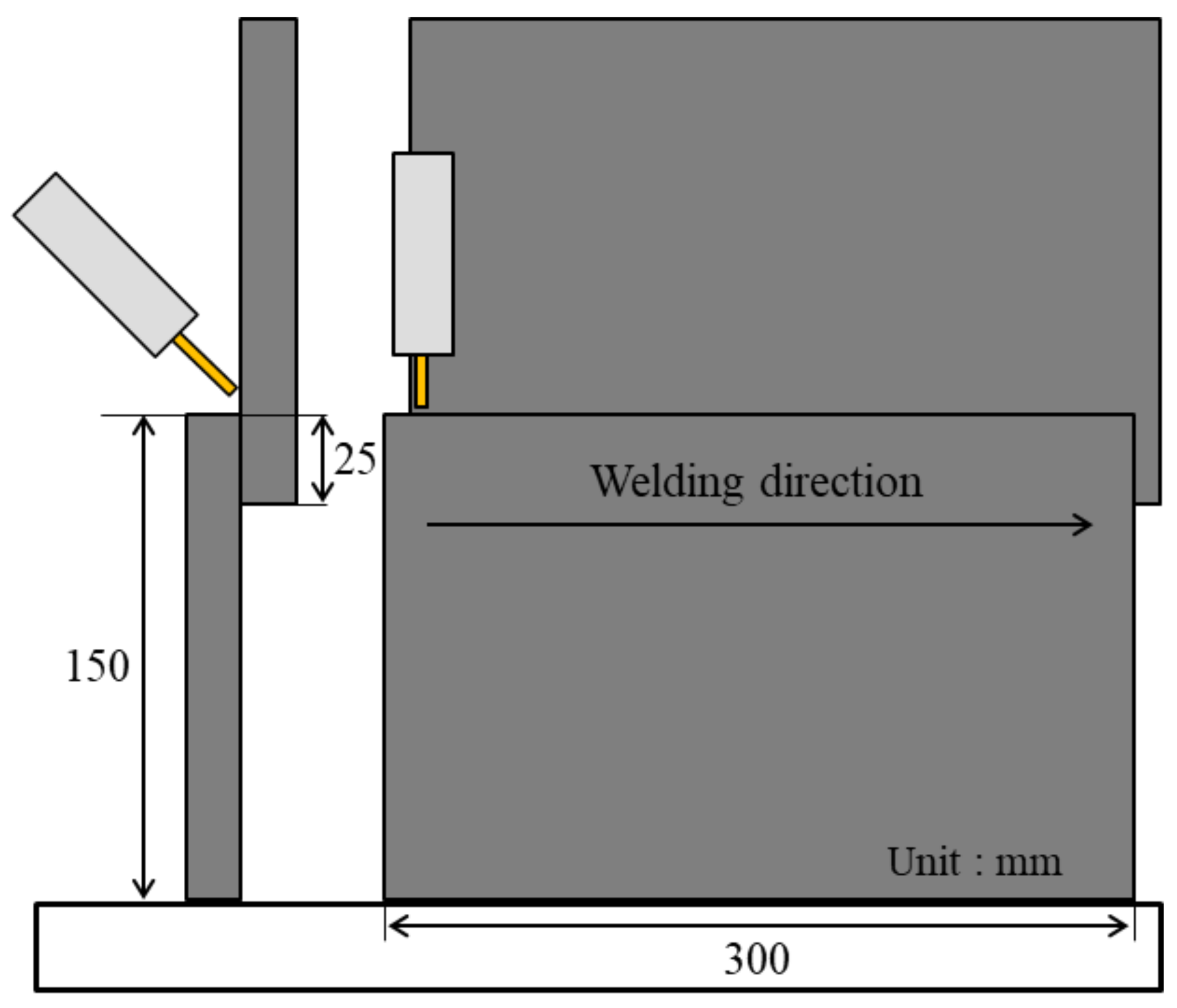
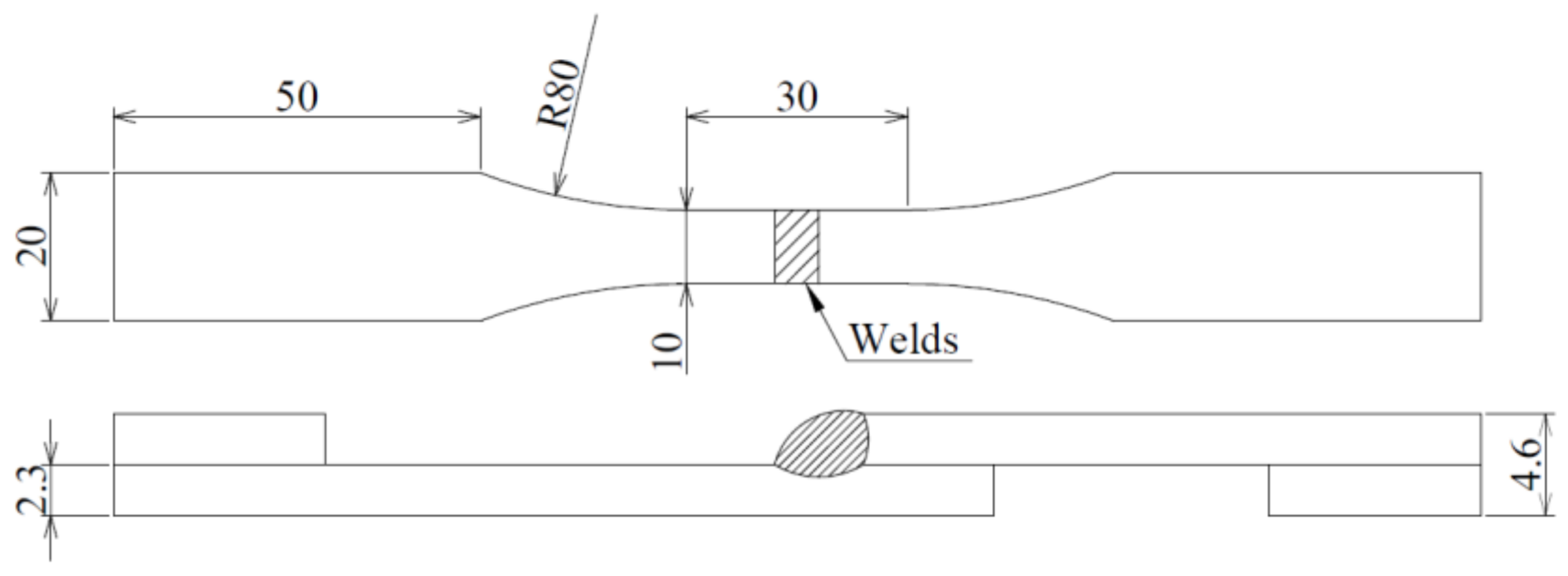
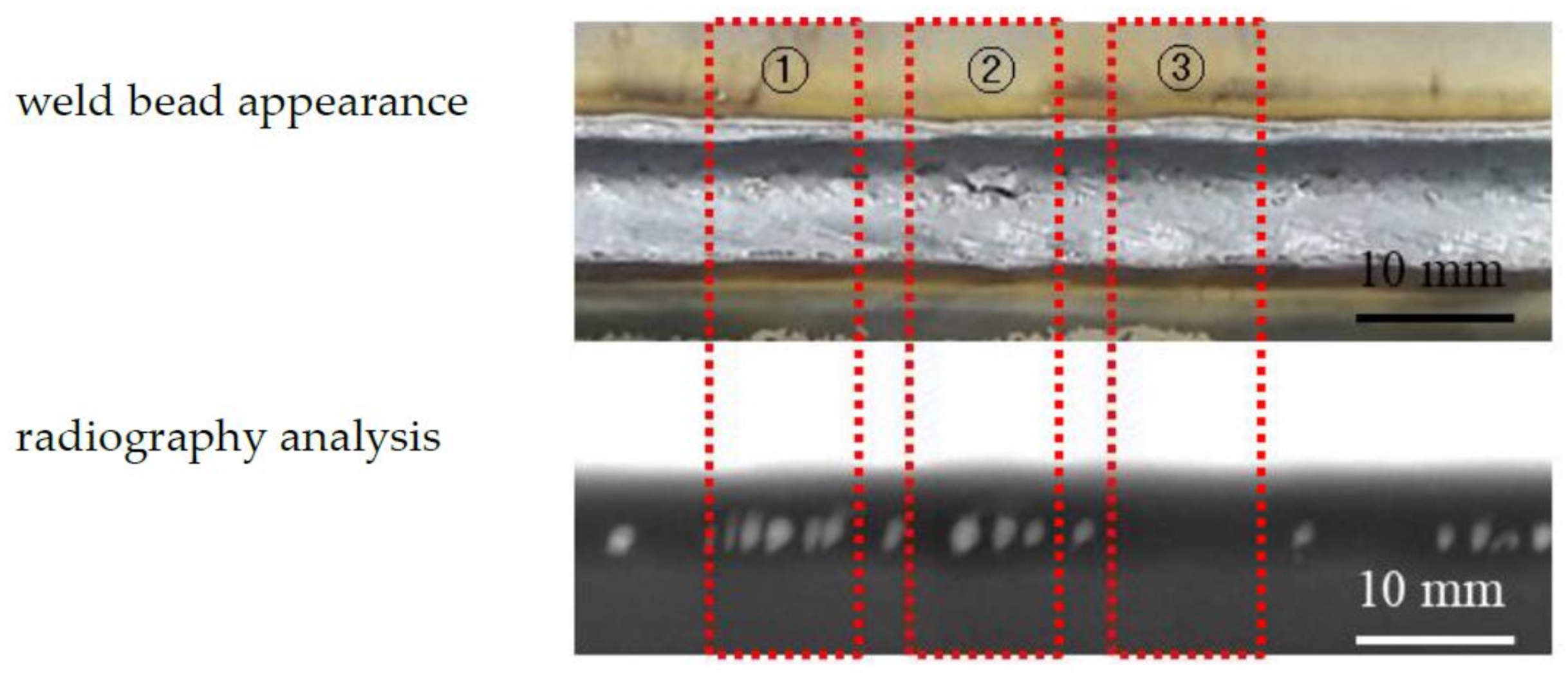
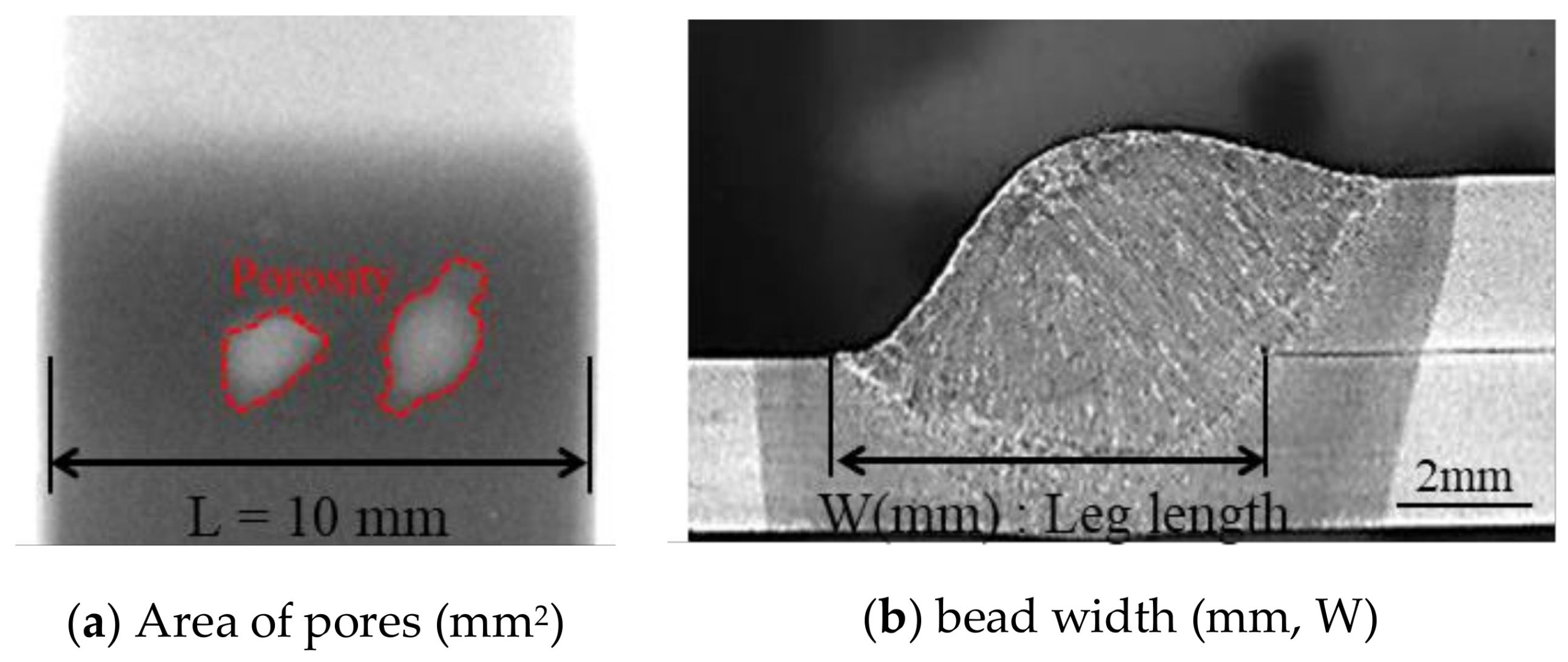
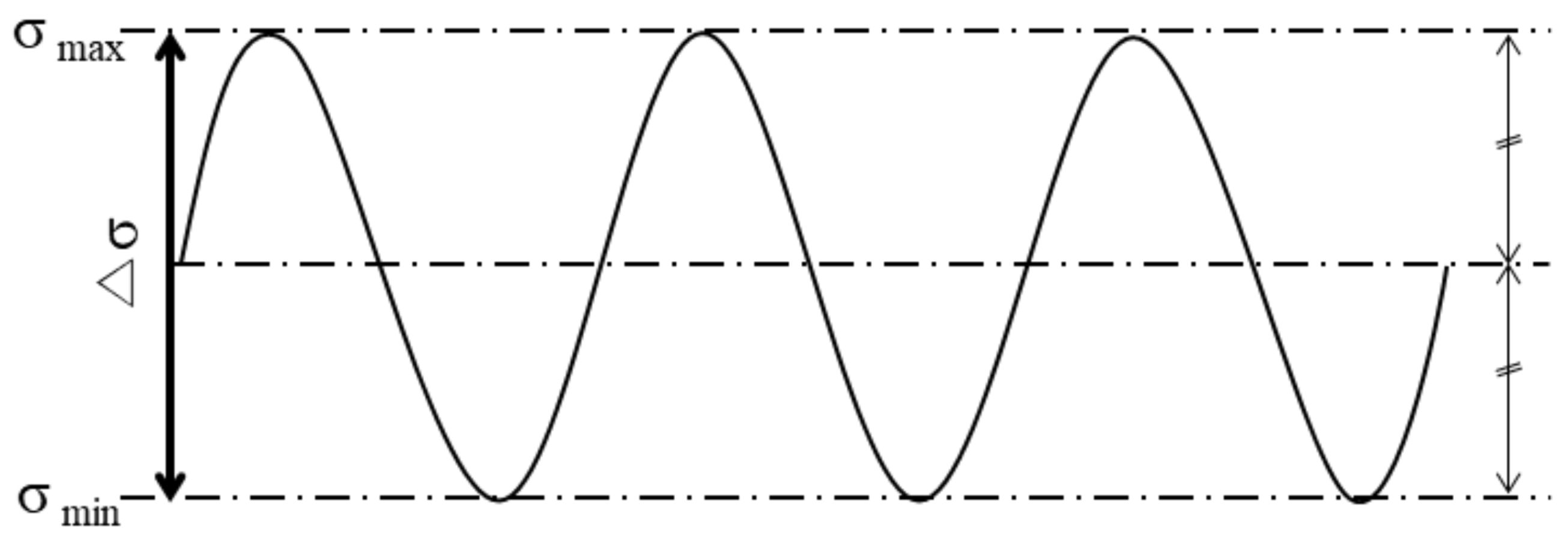

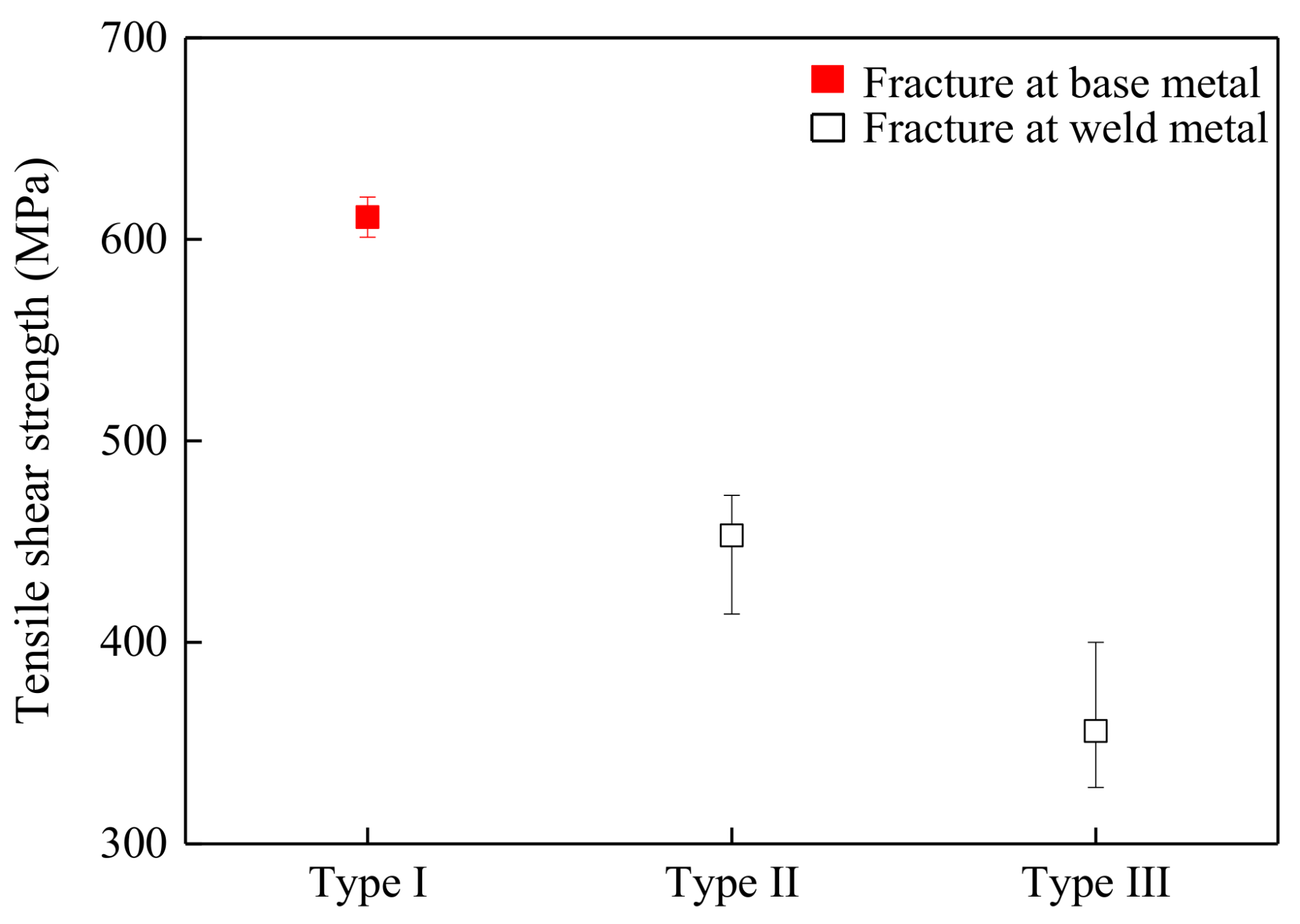
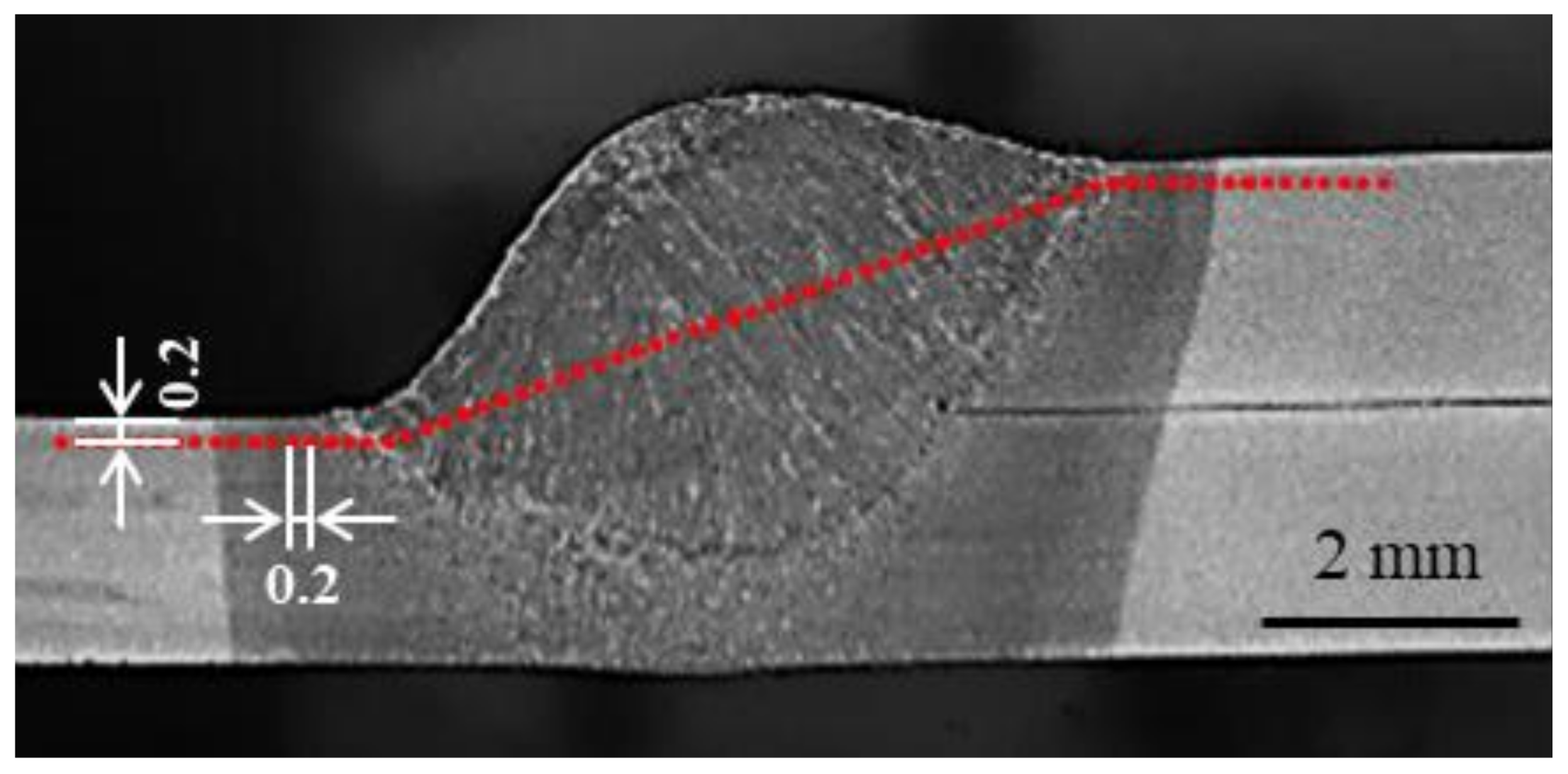
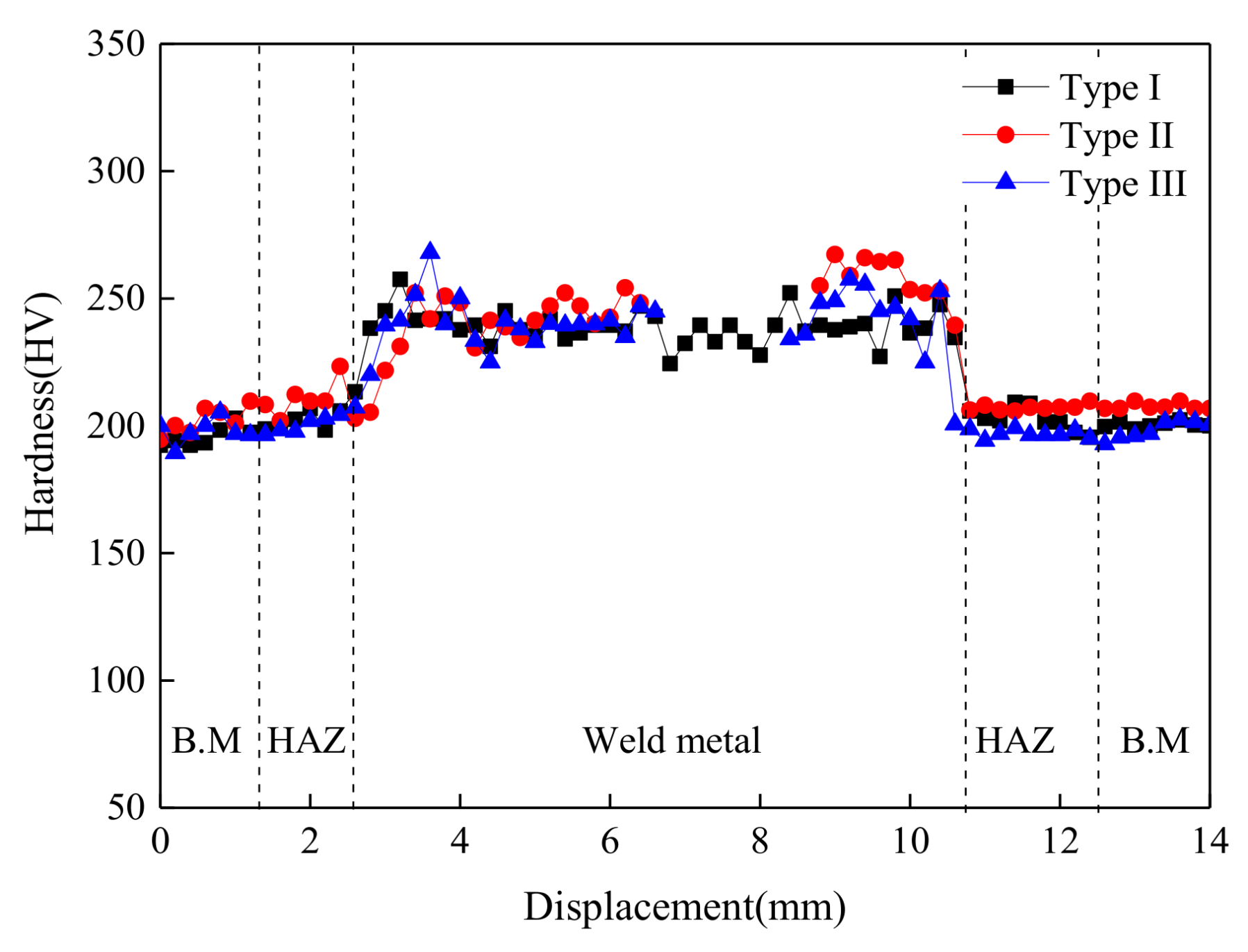
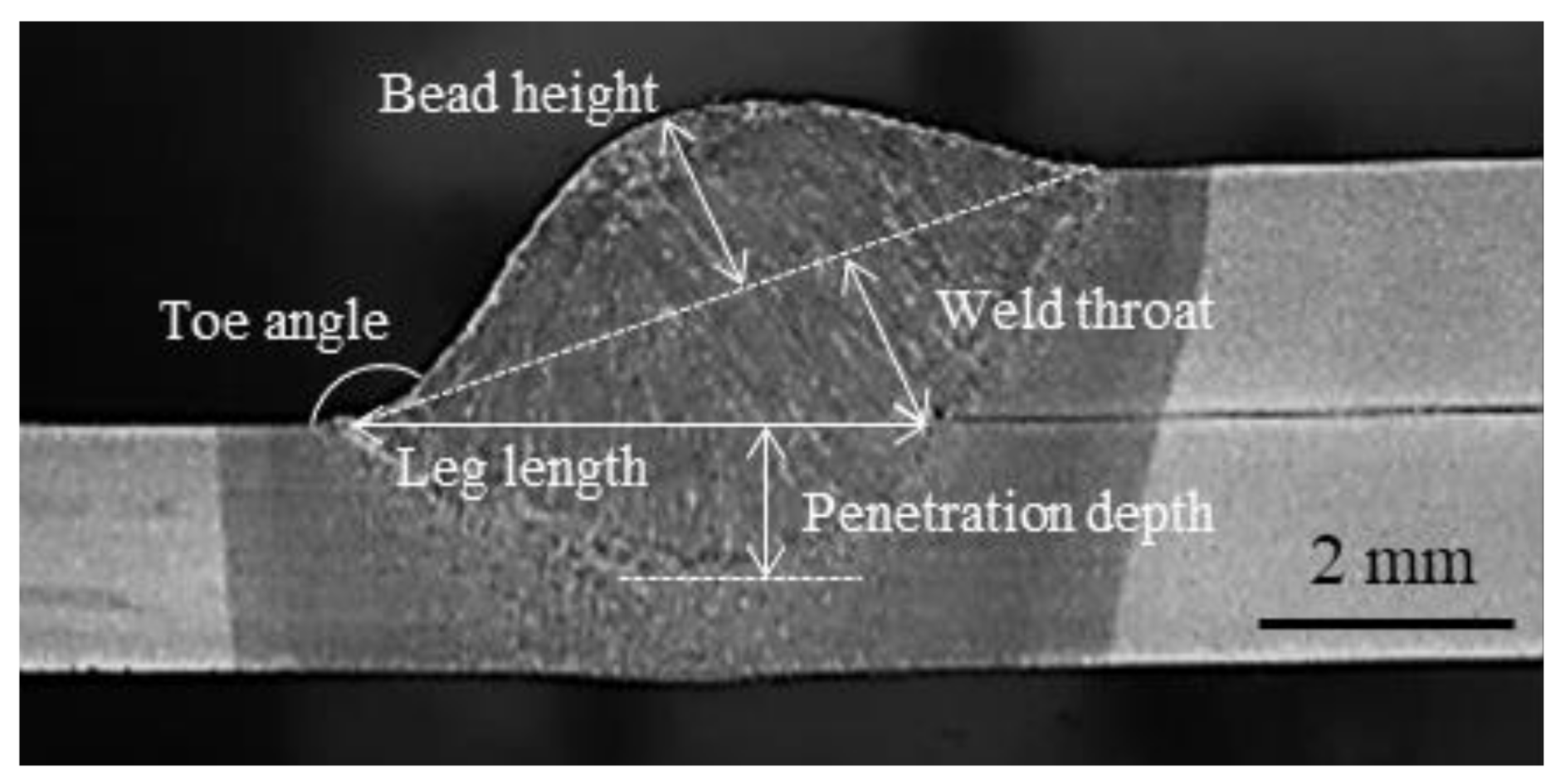
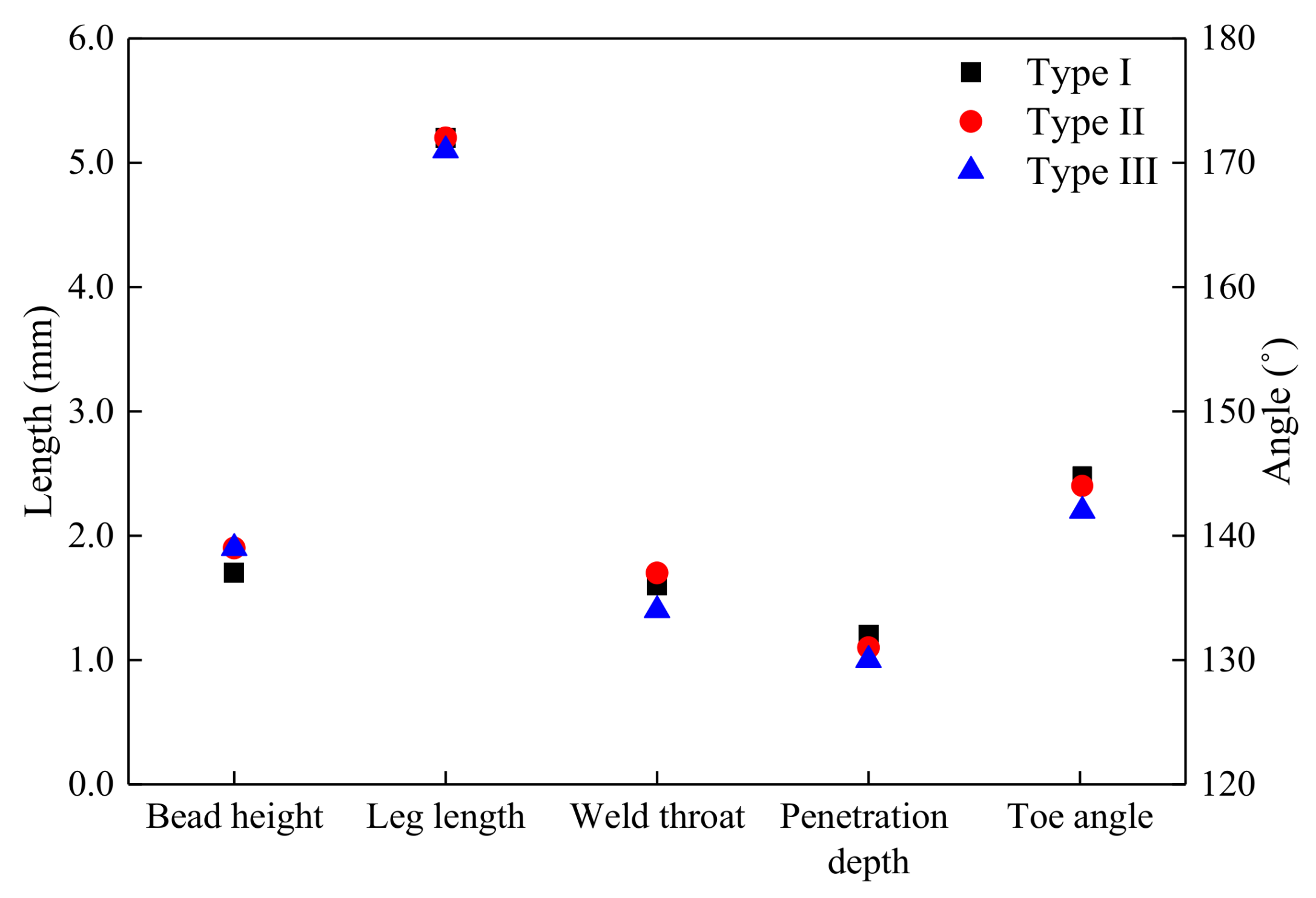
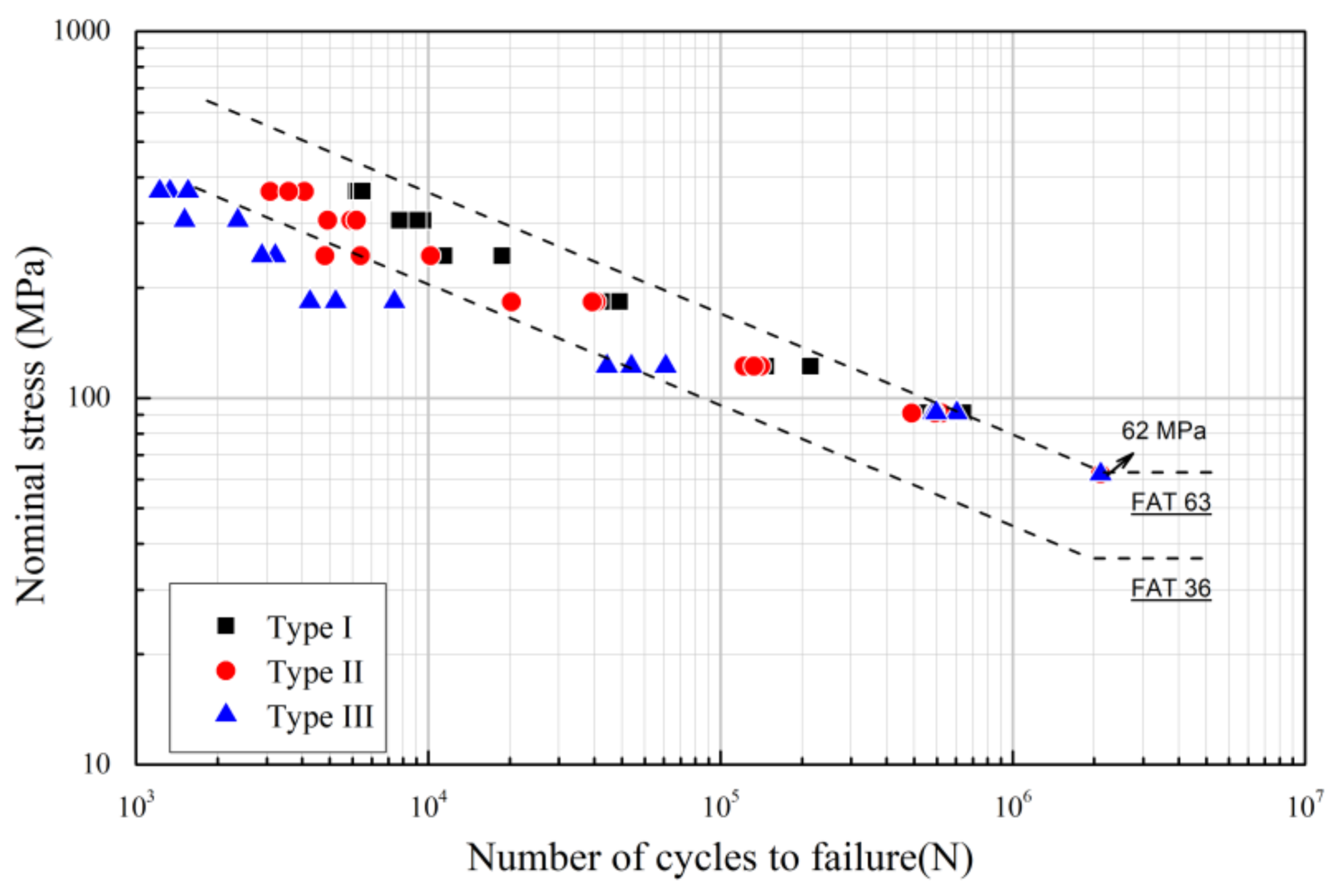

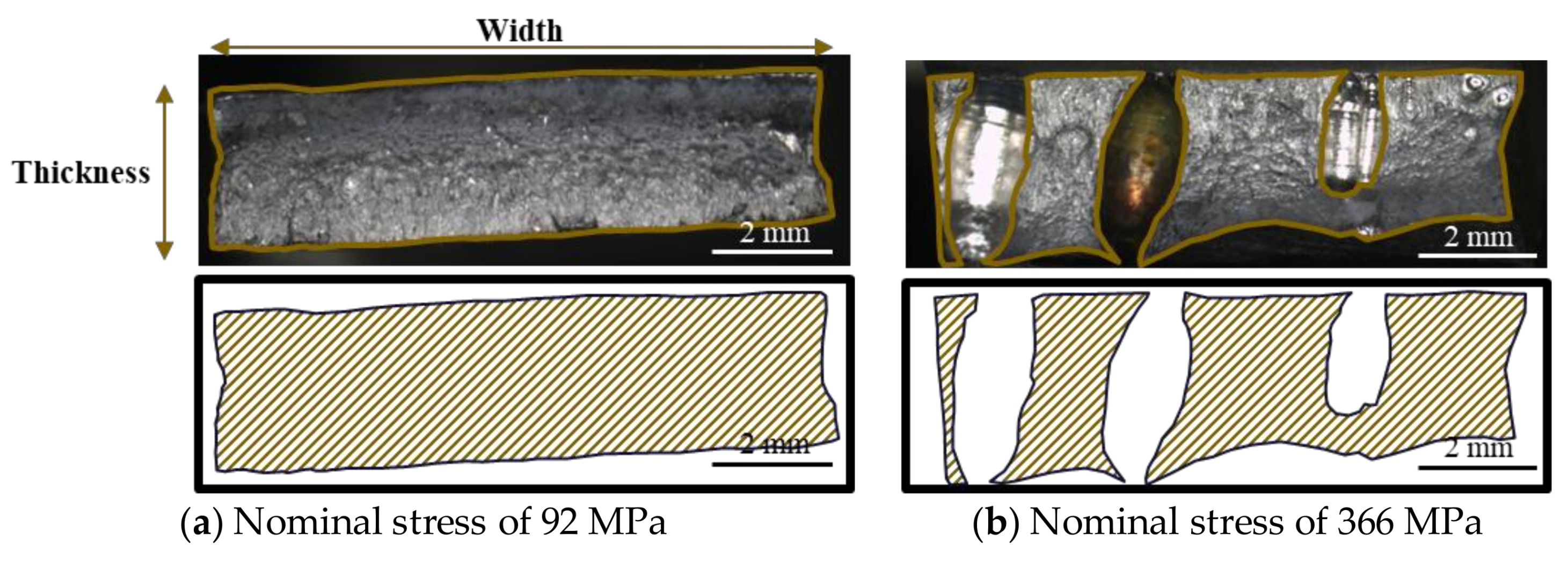
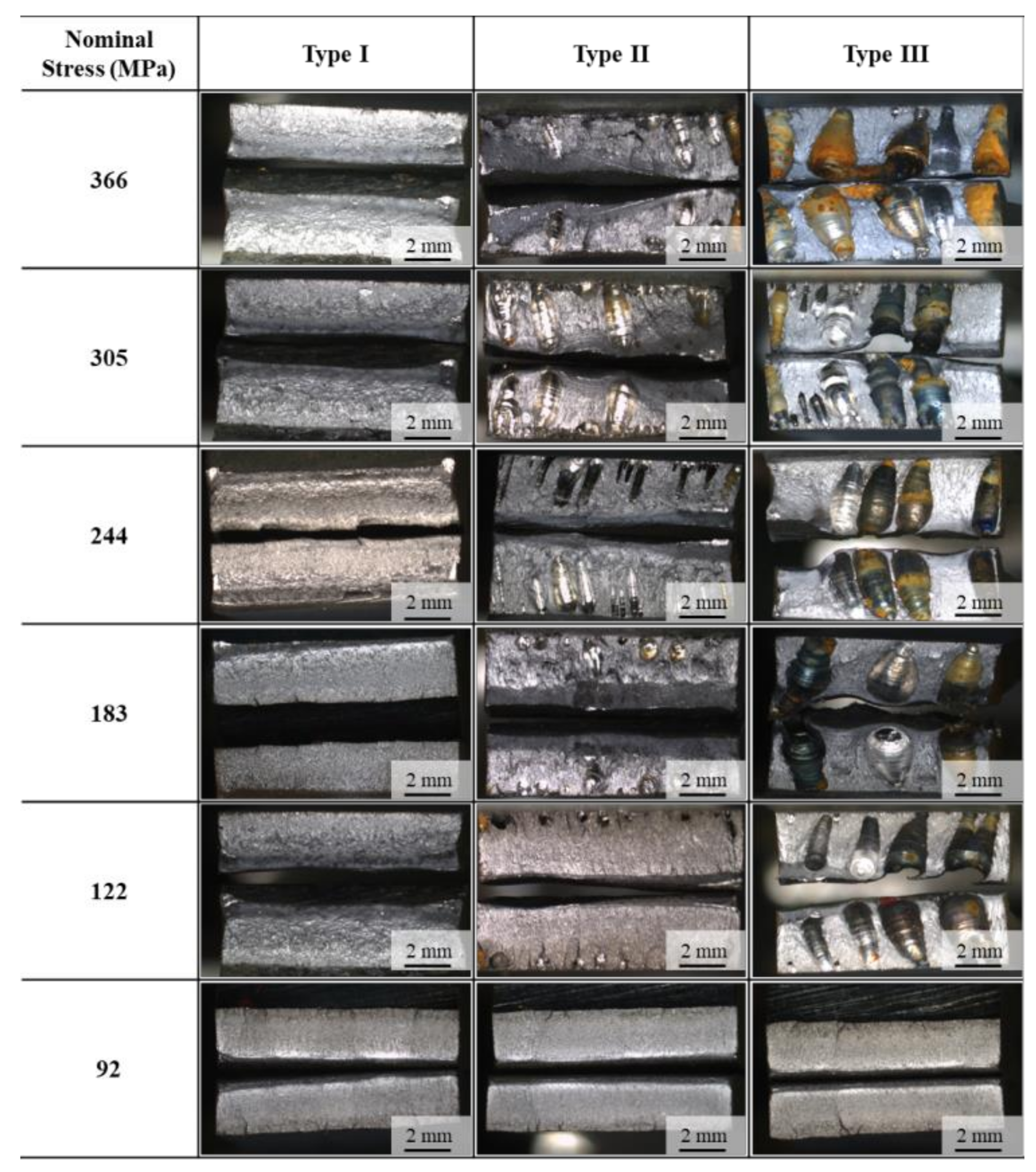
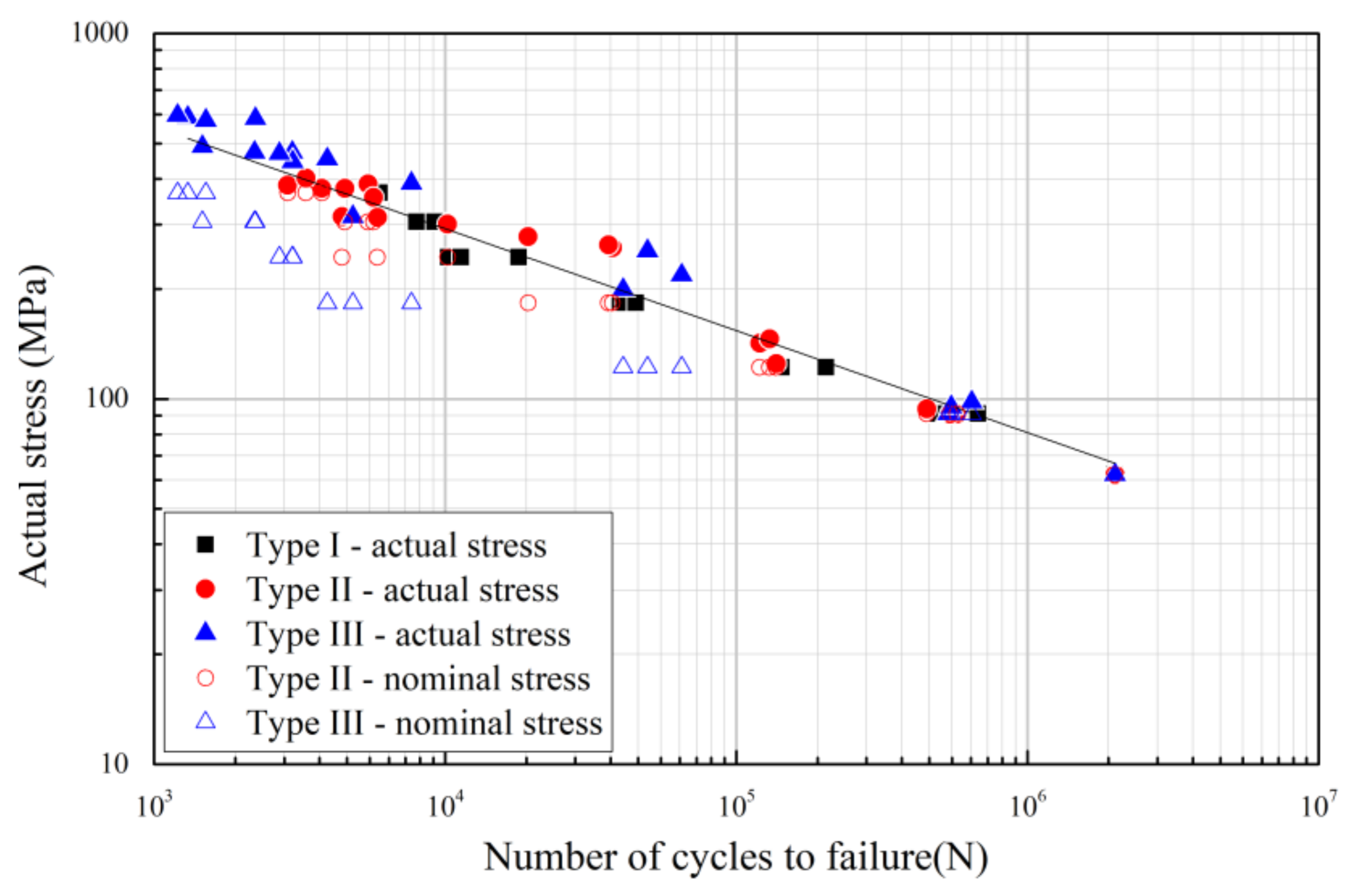
| Materials | Chemical Composition (wt. %) | Mechanical Properties | |||||||
|---|---|---|---|---|---|---|---|---|---|
| GA 590 FB | C | Si | Mn | P | S | Fe | Yield Strength (MPa) | Tensile Strength (MPa) | Elongation (%) |
| 0.07 | 0.14 | 1.440 | 0.013 | 0.002 | Bal. | 583 | 610 | 25 | |
| Welding Wire | Chemical Composition (wt. %) | Mechanical Properties of Weld Metal | |||||||
|---|---|---|---|---|---|---|---|---|---|
| ER70S-3 | C | Si | Mn | P | S | Fe | Yield Strength (MPa) | Tensile Strength (MPa) | Elongation (%) |
| 0.07 | 0.65 | 1.14 | 0.015 | 0.010 | Bal. | 440 | 560 | 28 | |
| Welding Process | Direct Current |
|---|---|
| wire feeding speed | 7.0 m/min |
| welding current/voltage | 237 A/22.7 V |
| welding speed | 80 cm/min |
| work angle | 45° |
| shielding gas | 90% Ar + 10% CO2 (20 ℓ/min) |
| Type of Specimens | Surface Pore (Number, ≥1.0 mm2) | Porosity (%) |
|---|---|---|
| Type I | 0 | 0 |
| Type II | 0 | 10–20 |
| Type III | 1–3 | 10–20 |
© 2018 by the authors. Licensee MDPI, Basel, Switzerland. This article is an open access article distributed under the terms and conditions of the Creative Commons Attribution (CC BY) license (http://creativecommons.org/licenses/by/4.0/).
Share and Cite
Kim, D.-Y.; Hwang, I.; Jeong, G.; Kang, M.; Kim, D.; Seo, J.; Kim, Y.-M. Effect of Porosity on the Fatigue Behavior of Gas Metal Arc Welding Lap Fillet Joint in GA 590 MPa Steel Sheets. Metals 2018, 8, 241. https://doi.org/10.3390/met8040241
Kim D-Y, Hwang I, Jeong G, Kang M, Kim D, Seo J, Kim Y-M. Effect of Porosity on the Fatigue Behavior of Gas Metal Arc Welding Lap Fillet Joint in GA 590 MPa Steel Sheets. Metals. 2018; 8(4):241. https://doi.org/10.3390/met8040241
Chicago/Turabian StyleKim, Dong-Yoon, Insung Hwang, Geunho Jeong, Munjin Kang, Dongcheol Kim, Jongdock Seo, and Young-Min Kim. 2018. "Effect of Porosity on the Fatigue Behavior of Gas Metal Arc Welding Lap Fillet Joint in GA 590 MPa Steel Sheets" Metals 8, no. 4: 241. https://doi.org/10.3390/met8040241
APA StyleKim, D.-Y., Hwang, I., Jeong, G., Kang, M., Kim, D., Seo, J., & Kim, Y.-M. (2018). Effect of Porosity on the Fatigue Behavior of Gas Metal Arc Welding Lap Fillet Joint in GA 590 MPa Steel Sheets. Metals, 8(4), 241. https://doi.org/10.3390/met8040241






